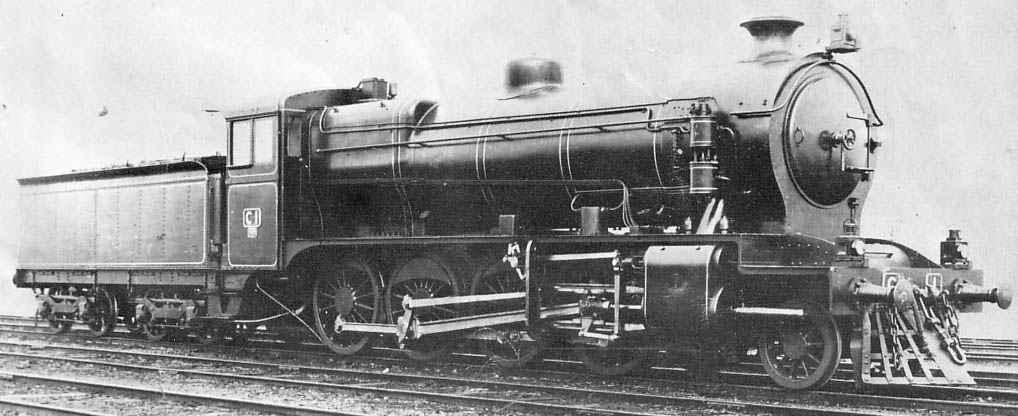- Victorian Railways C class
Infobox Locomotive
name = Victorian Railways C Class
caption = VR photograph of C 1, as built in 1918.
powertype = steam
data for = Victorian Railways C class
designer = W. M. Shannon
builder = Newport Workshops
builddate = 1918–1926
whytetype =2-8-0
uicclass = 1'Dh2
gauge = RailGauge|63|lk=on
totalproduction = 26
leadingsize = convert|3|ft|1.4375|in|m|3|abbr=on
driversize = convert|5|ft|1.6875|in|m|3|abbr=on
length = convert|65|ft|3|in|m|2|abbr=on
height = convert|13|ft|9|in|m|2|abbr=on
axleload = 18 tons 10 cwt (18.8 tonnes)
weightondrivers = 71 tons 18 cwt (73.1 tonnes) roadworthy
tenderweight = 47 tons 0 cwt (47.8 tonnes)
locotenderweight = 128 tons 10 cwt (130.6 tonnes)
tendercconvert|1500|impgal|abbr=on|lk=on oil, convert|4700|impgal|abbr=on water
cylindercount = Two, outside
cylindersize = 22 × 28 in (559 × 711 mm)
valvegear = Walschaerts
tractiveeffort = convert|38400|lbf|kN|2|abbr=on|lk=on at 85% boiler pressure
firearea = convert|32|sqft|m2|abbr=on
fireboxarea = convert|175|sqft|m2|abbr=on
tubesandflues = convert|1915|sqft|m2|abbr=on
superheaterarea = convert|327|sqft|m2|abbr=on
totalsurface = convert|2417|sqft|m2|abbr=on
boilerpressure = convert|200|psi|MPa|abbr=on|lk=on
factorofadhesion = 4.26
roadnumber = C1 to C26
firstrundate = 1918
lastrundate = 1962The C class was a mainline goods locomotive of the2-8-0 'Consolidation' type that ran on theVictorian Railways between 1918 and 1962. Although its original design had some key shortcomings, a number of improvements were made over the class' long career on the VR, many of which were subsequently applied to other locomotive classes on the system.History
Designed by Chief Mechanical Engineer W. M. Shannon,cite book| author=Oberg, Leon| title=Locomotives of Australia| publisher=Reed |location=Sydney | year=1975| pages=p. 127| id=ISBN 0-589-07173-4 |] the C class was the first goods locomotive designed and built entirely in-house by the Victorian Railways Newport Workshops, following on from the successful Dd and A2 class passenger locomotives. When introduced in 1918, they were the heaviest and most powerful steam locomotives in Australia.cite book| author=Pearce et al| title=North Williamstown Railway Museum| publisher=ARHS |location=Melbourne | year=1980| pages=p. 12| id=ISBN 0-85849-018-8 |]
Production
The prototype locomotive C 1 was the last locomotive to be painted in the Victorian Railways 'Canadian Red' scheme. Locomotive C 2 was the first new locomotive finished in the new VR livery of plain, unrelieved black. It was the first of a further 25 C class members also built at Newport Workshops between 1921 and 1926.
Design improvements
In practice, the C class was initially a somewhat less successful design than the A2. Key shortcomings included a very long, convert|9|ft|7|in manually stoked firebox that was difficult to fire and prone to clinkering, and an undersized boiler.cite web|url=http://www.victorianrailways.net/motive%20power/csteam.html| title=C class steam locomotives| publisher=victorianrailways.net| accessdate=2007-03-31|] The locomotives tended to run out of steam when worked hard.
In an attempt to rectify these problems, locomotive C 5 was fitted in 1933 with 'Modified Front End', a streamlining of the steam passages and other changes designed to reduce back pressure on the exhaust side and increase efficiency. The success of Modified Front End was such that the rest of the C class was progressively modified, as well as all of the A2, K, N, S and X classes.
In 1929, C 5 also became the first VR locomotive to be fitted with a cross-compound air compressor, which was also subsequently adopted across other VR locomotive classes.. The C class was also the first goods locomotive to be fitted with
Automatic Staff Exchange apparatus, given their frequent used on express goods and fruit services.As the poor quality of coal available after
World War II exacerbated the problems of firing the C class and industrial action in the mines threatened supply, the entire class was converted to oil firing from 1946 onwards following an initial conversion of C 15 in 1946. Despite the success of the conversion, C class locomotives were still prone to running out of steam when pushed on long rising gradients.Whereas other VR locomotives to receive Modified Front End treatment had been equipped with
smoke deflectors in the 1930s, it was not until 1947 that the VR finally developed a successful design of smoke deflector for the C class, based on the German "Witte" pattern. This design was then adopted for the final Newport-built N class locomotives as well as the last two steam locomotive classes on the VR, the R and J classes.Experimental use of Pulverised Brown Coal
In 1923, C 16 was modified with Fuller-Lehigh equipment to run on Pulverised Brown Coal (PBC), a potentially abundant fuel in Victoria given the large brown coal reserves in the
Latrobe Valley . Unlike the later conversion of X class locomotive X 32 to PBC firing in 1949, this early experiment was not considered a success and C 16 was returned to black coal operation ["Pulverised Brown Coal Fuel for Steam Locomotives" Buckland, John L. Australian Railway Historical Society Bulletin, July, 1972 pp145-161] .Passenger use
During
World War II , increasingly heavy passenger trains and a shortage of suitable motive power saw the C class used as mainline passenger locomotives, a somewhat unusual assignment for a 2-8-0. To facilitate passenger working, their maximum allowable speed was raised from 50 mph (80km/h ) to 60 mph (96 km/h) on the key North Eastern, Ballarat, Bendigo and Geelong lines.Withdrawal
The postwar rebuilding of Victorian Railways in the late 1940s and early 1950s saw the order of hundreds of new locomotives of superior design to the C class, culminating in the delivery of B class mainline diesel electric and L class mainline
electric locomotive s.With these new locomotives entering service, the ageing C class locomotives were progressively withdrawn from service, commencing with C 20 in June 1954. The last C class in service, C 7, was withdrawn in April 1962.
Preservation
C 10 was set aside for preservation on 18th May 1962, after having run convert|1160856|mi|km during its career on the VR. It is today preserved at the ARHS North Williamstown Railway Museum.
References
External links
* [http://www.victorianrailways.net/motive%20power/csteam.html C class locomotive history and photographs]
Wikimedia Foundation. 2010.
